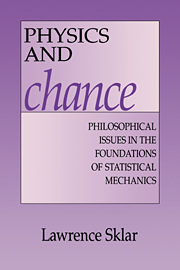Book contents
- Frontmatter
- Contents
- Preface
- 1 Introduction
- 2 Historical sketch
- 3 Probability
- 4 Statistical explanation
- 5 Equilibrium theory
- 6 Describing non-equilibrium
- 7 Rationalizing non-equilibrium theory
- 8 Cosmology and irreversibility
- 9 The reduction of thermodynamics to statistical mechanics
- 10 The direction of time
- 11 The current state of major questions
- References
- Index
9 - The reduction of thermodynamics to statistical mechanics
Published online by Cambridge University Press: 04 December 2009
- Frontmatter
- Contents
- Preface
- 1 Introduction
- 2 Historical sketch
- 3 Probability
- 4 Statistical explanation
- 5 Equilibrium theory
- 6 Describing non-equilibrium
- 7 Rationalizing non-equilibrium theory
- 8 Cosmology and irreversibility
- 9 The reduction of thermodynamics to statistical mechanics
- 10 The direction of time
- 11 The current state of major questions
- References
- Index
Summary
Philosophical models of intertheoretic reduction
Positivist versus derivational models of reduction
The progress of science is marked by the continual success of attempts to unify a greater and greater range of phenomena in more and more comprehensive theoretical schemes. This unifying process often takes the form of a theory that encompasses the phenomena in one domain of experience being “reduced” to some other theory, the full range of phenomena handled by the reduced theory now being handled by the reducing theory. And the reducing theory continues to do justice to the phenomena for which it was originally designed as well.
Examples are manifold. We are told that Kepler's laws of planetary motion reduced to Newtonian mechanics, that Newtonian mechanics reduced to special relativity, and special relativity to general relativity. On the other hand, we are told that Newtonian mechanics reduced to quantum mechanics. The physical optical theory of light allegedly reduces to the theory of electromagnetism, a theory already obtained by the search for the unifying account to which the earlier separate theories of electricity and magnetism reduced. Nowadays we are told that the quantum theory of electromagnetism (quantum electrodynamics) reduces to the electro-weak quantum field theory and that there are hopes that theory will reduce, along with the quantum field theoretic account of strong interactions, to the grand unified theory.
- Type
- Chapter
- Information
- Physics and ChancePhilosophical Issues in the Foundations of Statistical Mechanics, pp. 333 - 374Publisher: Cambridge University PressPrint publication year: 1993



